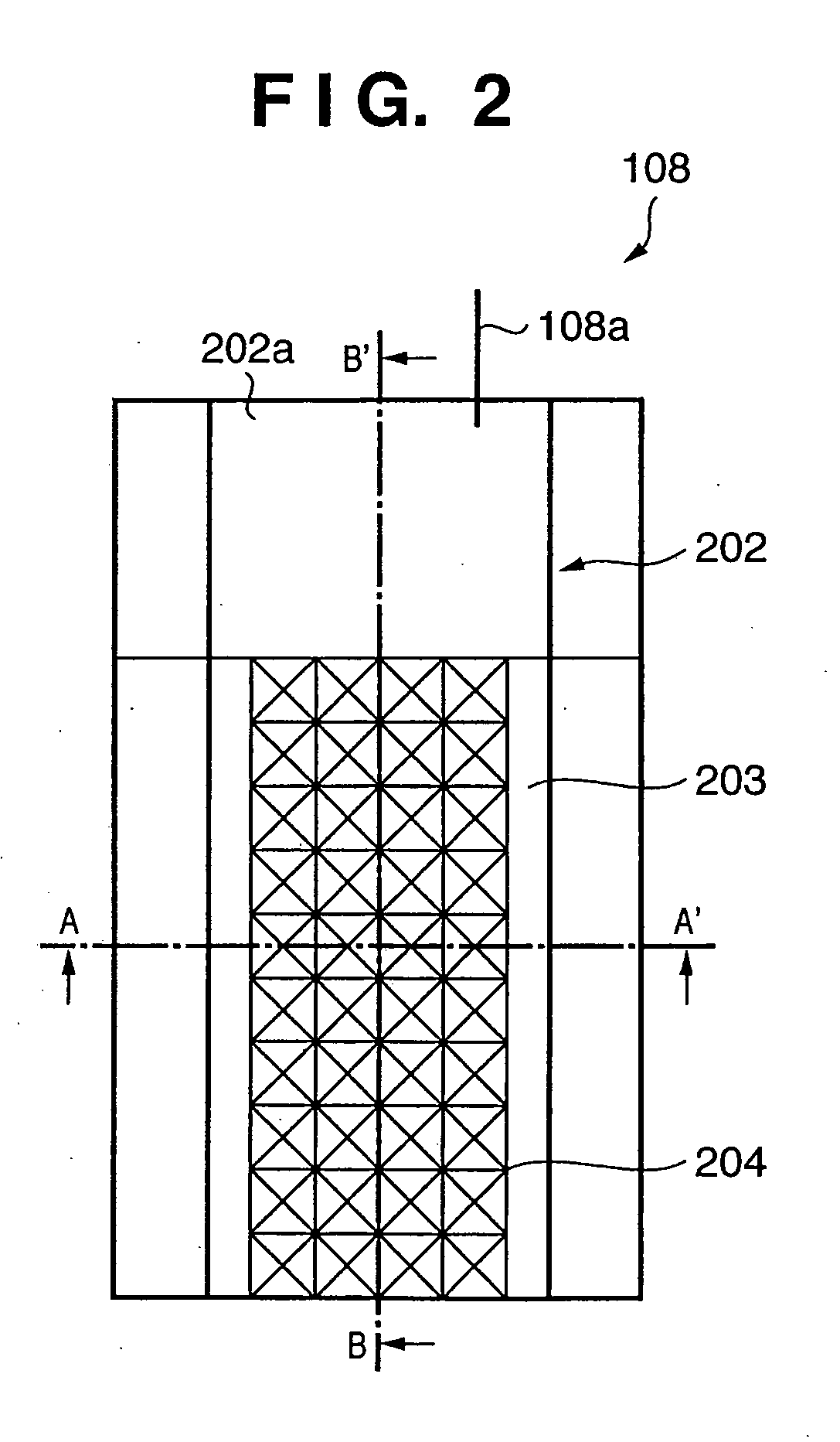Semiconductor device
a semiconductor device and noise control technology, applied in semiconductor devices, semiconductor/solid-state device details, electrical equipment, etc., can solve problems such as operation errors, power supply/ground wiring noise, operation errors, etc., to prevent operation errors, suppress noise propagation, and reduce radiation noise
- Summary
- Abstract
- Description
- Claims
- Application Information
AI Technical Summary
Benefits of technology
Problems solved by technology
Method used
Image
Examples
first embodiment
[0033]FIGS. 1, 2, 3, and 4 are views showing the first embodiment of the present invention. FIG. 1 is a view showing the outline of the layout of a semiconductor device according to the first embodiment. FIG. 1 corresponds to FIG. 16 which shows a prior art (to be described later). FIG. 2 shows the structure of a noise control cell 108 as a principal part of the first embodiment. FIGS. 3 and 4 are sectional views taken along a line A-A′ in FIG. 2. FIG. 5 is a sectional view of the noise control cell 108 taken along a line B-B′.
[0034] Referring to FIG. 1, a semiconductor device 101 comprises an internal circuit 102 and input / output circuit region 112. The input / output circuit region 112 comprises input / output cells (I / O cells) 103 which transmit signals between the internal circuit 102 and a device outside the semiconductor device 101, power supply wiring 107 and ground wiring 106 to supply a power and ground to the input / output cells 103, input / output circuit power supply cells 113...
second embodiment
[0046] FIGS. 6 to 13 show the second embodiment. The same reference numerals as in the first embodiment denote the same functional parts in the second embodiment, and a description thereof will be omitted.
[0047] The difference from the first embodiment is that extended noise control wiring 511 independently of input / output circuit power supply wiring 107 and ground wiring 106 and internal circuit power supply wiring 109 and ground wiring 110 are present in an input / output circuit region 512, the extended noise control wiring 511 automatically connect noise control cells 508 when normal input / output cells 503 and the noise control cells 508 are arranged, and the extended noise control wiring 511 are connected to the semiconductor substrate through contact vias. The noise control cell 508 has almost the same function as the noise control cell 108 of the first embodiment.
[0048] In the first embodiment, power supply noise and ground noise generated by the internal circuit operation ar...
third embodiment
[0058]FIG. 15 shows the third embodiment.
[0059] In this embodiment, the same input / output cells as in the first embodiment are used, and the semiconductor layout designer connects noise control cells 108 by wiring 1211. The wiring 1211 is connected to the semiconductor substrate. The semiconductor device designer connects the wiring 1211 to the semiconductor substrate arbitrarily by using wiring, vias, p+-, or n+-regions, as shown in FIG. 8, 9, 10, or 11.
[0060] As in the second embodiment, the noise absorption effect of the first embodiment can be increased. According to this embodiment, the noise control cells 108 are arbitrarily connected by the wiring 1211 only at a portion where noise propagation should be prevented. Hence, the area utilization ratio of the semiconductor device can be increased as compared to the structure of the second embodiment in which the noise control cells are always connected.
[0061] As described above, according to the above-described embodiment, the ...
PUM
 Login to View More
Login to View More Abstract
Description
Claims
Application Information
 Login to View More
Login to View More - R&D
- Intellectual Property
- Life Sciences
- Materials
- Tech Scout
- Unparalleled Data Quality
- Higher Quality Content
- 60% Fewer Hallucinations
Browse by: Latest US Patents, China's latest patents, Technical Efficacy Thesaurus, Application Domain, Technology Topic, Popular Technical Reports.
© 2025 PatSnap. All rights reserved.Legal|Privacy policy|Modern Slavery Act Transparency Statement|Sitemap|About US| Contact US: help@patsnap.com



